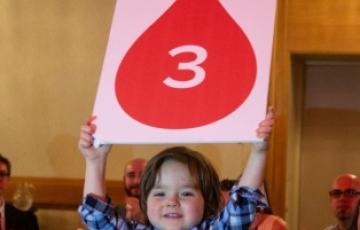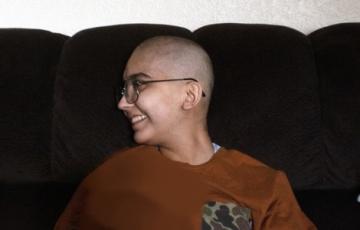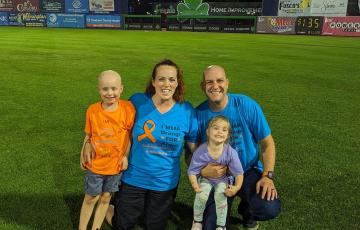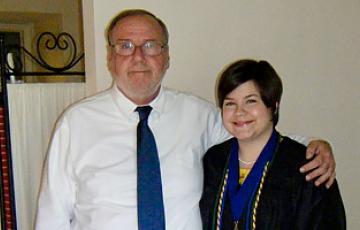Search Results

Stanley
Stanley was only 13 months old when he was diagnosed. He was a happy and healthy baby boy. Showing no previous symptoms or signs of sickness, Stanley was rushed to the ER one late Wednesday night because his parents, Joe and Krissi, thought he might have swallowed something. That was December 16, 2015. By 8p.m.

Heriberto
I was diagnosed with Burkitt lymphoma (BL) on Friday the 13th ― August 13, 2021, to be exact ― seven months after being married, three months after my wedding reception, and going on my honeymoon.
Watch and Wait
Not all CLL patients need to start treatment immediately. “Watch and wait” is a valid treatment approach that means your doctor will watch your condition but not give you treatment unless you have signs or symptoms that appear or change. This approach includes:

Yesenia
My name is Yesenia and this is my story. I began my first semester of university in fall 2017. While I was away for college I started experiencing some symptoms. It started off with nausea, after the first couple weeks of fall semester I would experience this sensation that left me bed ridden. This led me to go back to my family home so I could be better taken care of. I knew at that point that something wasn't right, so I took a trip to Urgent Care where I was told I was Anemic, but with a better diet I would go back to normal.
Treatment
There is not one treatment that is effective for all myelofibrosis (MF) patients. Patients have varying symptoms and circumstances that require different treatment options. Some MF patients remain symptom-free for many years and do not require immediate treatment. All MF patients, however, need to be closely monitored.
Treatment
It's important that your doctor is experienced in treating patients with hairy cell leukemia or works in consultation with a hairy cell leukemia specialist. This type of specialist is usually called a hematologist oncologist.
Types of Hairy Cell Leukemia TreatmentFor many people with hairy cell leukemia, starting treatment helps them focus on moving ahead and looking forward to their disease's remission.
Several types of approaches and treatment are used for adults with hairy cell leukemia, some at different stages:
When Your Child Has Cancer
Hearing that your child has cancer is terrifying for any parent. Today, most childhood cancer patients can expect to have full and productive lives. Many childhood cancer survivors return to school, attend college, enter the workforce, marry and become parents. Nevertheless, being vigilant about follow-up care, being aware of long-term and late effects of treatment, helping your child return to school and even dealing with your emotions are all things you’ll need to manage.
Understanding Blood Cancers and Treatment Options
Leukemia, lymphoma, myeloma, myelodysplastic syndromes (MDSs) and myeloproliferative neoplasms (MPNs) are types of cancer that can affect the bone marrow, blood cells, lymph nodes and other parts of the lymphatic system. See the Disease Information pages to learn more about the different types of blood cancer.
Diagnosis
While certain signs and symptoms may indicate that a person has ET, a series of tests are needed to confirm the diagnosis. It is important to have an accurate diagnosis, as it helps the doctor to:
- Estimate how the disease will progress
- Determine the appropriate treatment
Some of these tests may be repeated both during and after treatment to evaluate its effectiveness.
Relapsed and Refractory
Refractory AML: Most patients achieve a remission (an absence of signs and symptoms) after initial treatment for acute myeloid leukemia (AML). However, some patients have residual leukemic cells in their marrow even after intensive treatment. Patients who have not achieved complete remission after two cycles of induction chemotherapy are usually diagnosed as having "refractory AML."
CML Phases and Prognostic Factors
CML has three phases. The phase of your chronic myeloid leukemia (CML) plays a large part in determining the type of treatment you'll receive. Doctors use diagnostic tests to determine the phase of CML. Determining the CML phase is based primarily on the number of immature white blood cells (blasts) in the patient’s blood and bone marrow.
Phases of CMLChronic Phase. Most patients are diagnosed with CML in the with chronic phase of the disease.
People with chronic phase CML:
Treatment for Indolent NHL Subtypes
Indolent non-Hodgkin lymphoma (NHL) subtypes progress slowly. They make up about 40 percent of all NHL cases in the United States. Indolent subtypes include:
Graft-Versus-Host Disease
Graft-versus-host disease (GVHD) is a potentially serious complication of allogeneic stem cell transplantation and reduced-intensity allogeneic stem cell transplantation. In this treatment, a patient’s own damaged or diseased blood-forming stem cells are destroyed. Then they are replaced with healthy stem cells from a donor.
Treatment
It's important that your doctor is experienced in treating patients with chronic leukemia or works in consultation with a chronic lymphocytic leukemia (CLL) specialist. This type of specialist is called a hematologist oncologist.
Types of CLL TreatmentCurrent therapies do not offer patients a cure for CLL, but there are treatments that help manage the disease. Doctors use several types of approaches and treatment for adults with CLL, some at different stages:

Gregg
The date was May 15, 2015, in the local office of the hematologist/oncologist and I was given this message after the results of my bone marrow biopsy taken a week earlier.
Side Effects
Both cancer therapy and acute myeloid leukemia (AML) can sometimes produce side effects. For most patients, side effects are temporary and subside once the body adjusts to therapy or when therapy is completed. For other patients, side effects can be more severe, sometimes requiring hospitalization. The side effects of chemotherapy may vary, depending on the drugs used and the overall health of the patient.
Talk with your child’s doctor about potential side effects. Medications and other therapies can prevent or manage many side effects.
Diagnosis
While certain signs and symptoms may indicate that a person has PV, a series of tests are needed to confirm the diagnosis. It is important to have an accurate diagnosis, as it helps the doctor to:
- Estimate how the disease will progress
- Determine the appropriate treatment
Evaluation of an individual with suspected PV should start with a detailed medical history and a physical examination.
The medical history should include information about the patient’s:
Infections
Cancer patients, especially those undergoing chemotherapy, are more likely to get infections because of their weakened immune systems. Cancer and certain cancer therapies can damage the immune system by reducing the number of infection-fighting white blood cells. Patients with a low white blood cell count are at a higher risk of developing infections, and these infections can be more serious and harder to treat. In severe cases, infections can lead to death.
Side Effects
Both cancer therapy and acute myeloid leukemia (AML) can produce side effects. For most patients, side effects are temporary and subside once the body adjusts to therapy or when therapy is completed. For other patients, side effects can be more severe, sometimes requiring hospitalization. The side effects of chemotherapy may vary, depending on the drugs used and the overall health of the patient.
Before you undergo treatment, talk with your doctor about potential side effects. Medication and other therapies can prevent or manage many side effects.
Cancer-Related Fatigue
Fatigue is very common in patients with blood cancers. Cancer-related fatigue (CRF) is characterized by excessive and persistent exhaustion that interferes with daily activity. CRF often begins before cancer is diagnosed, worsens during the course of treatment and may persist for months—even years—after treatment ends.
Chemotherapy and Drug Therapy
Chemotherapy drugs kill fast-growing cells throughout the body, including both cancer cells and normal, healthy cells. The damage to normal, healthy cells can cause side effects. Chemotherapy is typically given in cycles. Each cycle is made up of a certain number of days of treatment, followed by a certain number of days of rest.
Related Diseases
Myeloma shares some similar features and symptoms with other blood disorders, including:

Aiden
On November 6, 2022, God spoke to me and told me to take Aiden to the hospital. He had a lingering cough and random fevers that would come and go over the month. I took my parents to Philly airport and stopped by Nemours in Wilmington. I figured they would run some tests, and I would be told he had some infection. We would get medications and be on our way. When the nurse examined him, she asked about anything else going on. I mentioned he has had a lot of bruising lately, but he does karate and is a typical boy. We looked over his whole body, and I had not realized he had so many bruises!
Don
Like so many individuals diagnosed with blood cancer, I had zero thought that I might be ill, much less with a disease that could take my life.
I had signs and symptoms that something wasn’t quite right in my body, annoying things like shortness of breath, lightheadedness, and fatigue. However, nothing registered in my head until after my diagnosis.
It’s September 2005, and I am pretty much invincible, bulletproof! I could, in fact, leap tall buildings in a single bound! Yes, in my mind I was Superman!
